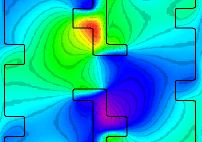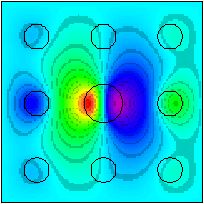
|
|
|
|
|
|
|
|
|
|
|
|
Resonant Cavities in Photonic Crystals
When a point defect is created in a photonic crystal, it is possible for that defect to pull a light mode into the band gap. Because such a state is forbidden from propagating in the bulk crystal, it is trapped. The mode decays exponentially into the bulk.

Such a point defect, or resonant cavity, can be utilized to produce many important effects. For example, it can be coupled with a pair of waveguides to produce a very sharp filter (through resonant tunnelling). Point defects are at the heart of many other photonic crystal devices, such as channel drop filters. Another application of resonant cavities is enhancing the efficiency of lasers, taking advantage of the fact that the density of states at the resonant frequency is very high (approaches a delta function).
The picture at right depicts a resonant cavity in our
three-dimensional structure, where the colors correspond to the value
of the magnetic field component perpendicular to the plane of the
image.

By changing the size or the shape of the defect, its frequency can easily be tuned to any value within the band gap. Moreover, the symmetry of the defect can also be tuned. By increasing the amount of dielectric in the defect, one can pull down higher-order modes, corresponding to the s, p, d, etcetera states in atoms. Here, we see a p-like state in a two-dimensional photonic crystal (square lattice of rods). The defect was created by increasing the radius of the center rod by 50%.